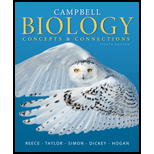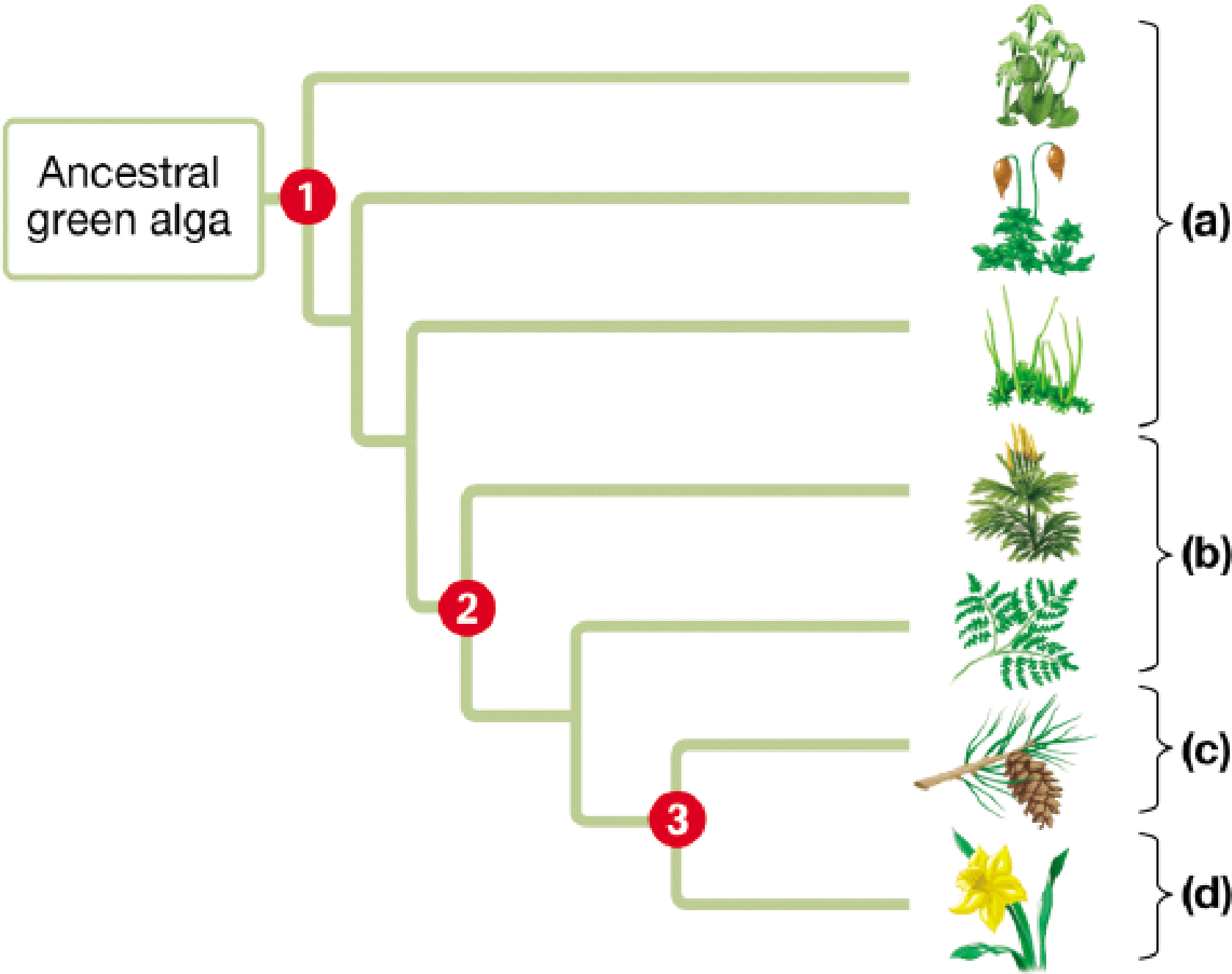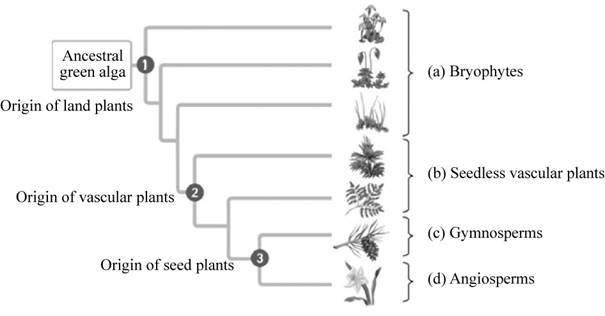
Concept explainers
In this abbreviated diagram, identify the four major plant groups and the key terrestrial adaptation associated with each of the three major branch points.

To determine: The four major plant group and their key terrestrial adaptation associated with each of the three major branch points.
Introduction:
The evolution of plants started with the origin of land plants that included the bryophytes. Land plants developed apical meristem and the embryos. After the land plants, the origin of vascular plants occurred. They involved the seedless fern and mosses. Lastly, the origin of seeded plants occurred. This includes the angiosperms and the gymnosperms.
Answer to Problem 1CC
Pictorial representation: The highlights of plant evolution are depicted in Fig.1.

Fig.1: The major events in plant evolution.
Explanation of Solution
The three distinct adaptations which gave rise to the four major plant groups are:
(1)
Correct answer: The origin of land plants.
Explanation:
The first terrestrial adaptation includes the origin of land plants. Their development included presence of the meristem and the embryos within the parent.
They include the major plant group (a) the bryophytes. The bryophytes are the non vascular plants and they evolved from the green algae about 475 million years ago. It included the development of apical meristem and embryos. For example: Mosses, hornworts, and liverworts. Hence, the correct answer is origin of land plants.
(2)
Correct answer: The origin of vascular plants.
Explanation:
The second adaptation includes the origin of vascular plants. It included the development of vascular tissues that helped the plants to grow tall and move away from the moist environment. They were now able to transport water to the leaves from the roots.
They include plant group (b) the seedless vascular plants. They evolved about 425 million years ago and include the ferns, club mosses and the horsetails. Hence, the correct answer is origin of vascular plants.
(3)
Correct answer: The origin of seed plants.
Explanation:
The third adaptation includes the origin of seed plants. They included the vascular seed plants. The seeds provided protection and dispersion of the embryos.
They include two major groups of plants:
Group (c) Gymnosperms: They include the seeded plants which have their seeds within the cones. They evolved about 360 million years ago. For example: pines, fir and spruce.
Group (d) Angiosperms: They include the vascular seeded plants that bear flowers. They evolved about 360 million years ago along with the gymnosperms. For example: rose, maple trees and oak trees. Hence, the correct answer is origin of seed plants.
Want to see more full solutions like this?
Chapter 17 Solutions
Campbell Biology: Concepts & Connections (8th Edition)
- What are Clathrin coated vesicles and what is their function?arrow_forwardHow is a protein destined for the Endoplasmic Reticulum (ER), imported into the ER? Be concise.arrow_forwardFind out about the organisations and the movements aimed at the conservation of our natural resources. Eg Chipko movement and Greenpeace. Make a project report on such an organisation.arrow_forward
- What are biofertilizers and mention the significancearrow_forwardPCBs and River Otters: Otters in Washington State’s Green-Duwamish River have high levels of polychlorinated biphenyls (PCBs) in their livers. PCBs can bind to the estrogen receptors in animals and disrupt the endocrine system of these otters. The PCBs seem to increase the estrogen to androgen ratio, skewing the ratio toward too much estrogen. How would increased estrogen affect the river otter population? Based on your reading of the materials in this unit, what factors can affect fertility in humans? Explain how each of the factors affecting human fertility that you described can disrupt the human endocrine system to affect reproduction.arrow_forwardOther than oil and alcohol, are there other liquids you could compare to water (that are liquid at room temperature)? How is water unique compared to these other liquids? What follow-up experiment would you like to do, and how would you relate it to your life?arrow_forward
- Selection of Traits What adaptations do scavengers have for locating and feeding on prey? What adaptations do predators have for capturing and consuming prey?arrow_forwardCompetition Between Species What natural processes limit populations from growing too large? What are some resources organisms can compete over in their natural habitat?arrow_forwardSpecies Interactions Explain how predators, prey and scavengers interact. Explain whether predators and scavengers are necessary or beneficial for an ecosystem.arrow_forward
- magine that you are conducting research on fruit type and seed dispersal. You submitted a paper to a peer-reviewed journal that addresses the factors that impact fruit type and seed dispersal mechanisms in plants of Central America. The editor of the journal communicates that your paper may be published if you make ‘minor revisions’ to the document. Describe two characteristics that you would expect in seeds that are dispersed by the wind. Contrast this with what you would expect for seeds that are gathered, buried or eaten by animals, and explain why they are different. (Editor’s note: Providing this information in your discussion will help readers to consider the significance of the research).arrow_forwardWhat is the difference between Uniporters, Symporters and Antiporters? Which of these are examples of active transport?arrow_forwardWhat are coupled transporters?arrow_forward
 Biology (MindTap Course List)BiologyISBN:9781337392938Author:Eldra Solomon, Charles Martin, Diana W. Martin, Linda R. BergPublisher:Cengage Learning
Biology (MindTap Course List)BiologyISBN:9781337392938Author:Eldra Solomon, Charles Martin, Diana W. Martin, Linda R. BergPublisher:Cengage Learning Concepts of BiologyBiologyISBN:9781938168116Author:Samantha Fowler, Rebecca Roush, James WisePublisher:OpenStax College
Concepts of BiologyBiologyISBN:9781938168116Author:Samantha Fowler, Rebecca Roush, James WisePublisher:OpenStax College Biology: The Dynamic Science (MindTap Course List)BiologyISBN:9781305389892Author:Peter J. Russell, Paul E. Hertz, Beverly McMillanPublisher:Cengage Learning
Biology: The Dynamic Science (MindTap Course List)BiologyISBN:9781305389892Author:Peter J. Russell, Paul E. Hertz, Beverly McMillanPublisher:Cengage Learning Biology 2eBiologyISBN:9781947172517Author:Matthew Douglas, Jung Choi, Mary Ann ClarkPublisher:OpenStax
Biology 2eBiologyISBN:9781947172517Author:Matthew Douglas, Jung Choi, Mary Ann ClarkPublisher:OpenStax





